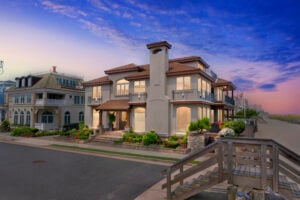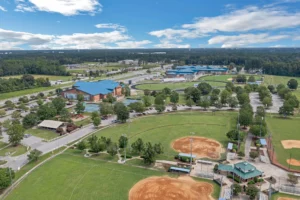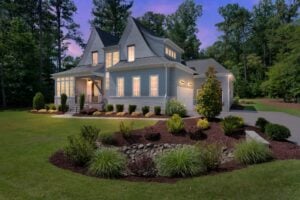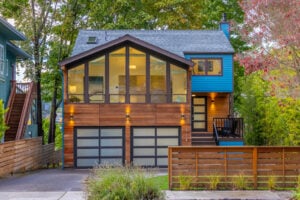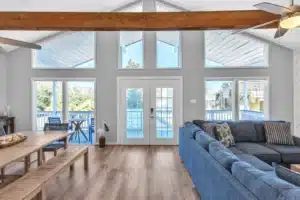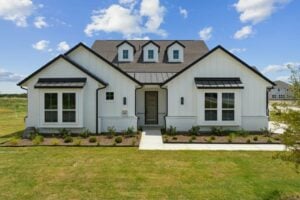The real estate market of today’s time appeals more to new construction homes than ever. Did you know that 50% of Americans now prefer new homes to existing ones, this is the reason for the growing trend towards modern, customized living spaces.
In this blog, we will discuss why these homes are not just a shelter but a smart investment choice. From the promise of instant equity and appreciation in emerging markets to the allure of low maintenance and the opportunity to personalize, new construction homes offer a unique modernity, convenience, and investment potential.
Modern Amenities: Investing in New Construction for Contemporary Living
Modern construction has become more than property; it’s a gateway to a life enriched by the latest amenities tailored to today’s lifestyle.
-
Cutting-Edge Technology and Appliances in New Construction Homes
Cutting-edge technology and applications are redefining modern living. New constructions now incorporate smart home technology, providing homeowners with seamless connectivity and control over their appliances and systems through a central hub or smartphone app.
This integration enhances convenience and security and significantly boosts energy efficiency. Advanced security features like motion-activated cameras and smart locks ensure safety, while the ability to create personalized automation routines for lighting, temperature, and entertainment adds to the allure.
These smart technologies are not just trendy; they future-proof the home, making it adaptable to upcoming technological advancements, and offer insights through data collection on energy usage, optimizing efficiency, and reducing costs.
-
Contemporary Design and Architecture: Choosing a New Construction Home Over an Existing One
Homeowners are shifting more towards designs that offer a blend of modernity and comfort. The movement away from open-concept floor plans towards more compartmentalized spaces, including home offices, libraries, and even spas, has gained traction.
This shift reflects a growing desire for cozy, personalized spaces post-pandemic. In Florida, you can see the clear benefits of new construction, as these modern designs often incorporate sustainable features and smart living solutions, aligning with the trend of ‘double aging.’
There’s a significant focus on sustainability and smart living as well. Architects in Florida are now integrating healthcare facilities and designing for limited mobility, enhancing urban connectivity. The state is also seeing a move towards adaptive reuse, repurposing disused buildings for new functions, which offers sustainable benefits and supports local communities.
-
Enhanced Safety Features: The Advantages of Investing in New Construction Real
Features such as smart locks, automated lighting, and comprehensive security systems can be controlled remotely, offering both peace of mind and a higher level of customization for safety measures. These systems integrate door and window sensors, motion detectors, surveillance cameras, smoke detectors, and more, all manageable via a smartphone app.
New construction homes often come with high-quality windows that are durable and easy to maintain and contribute to safety and energy efficiency. These windows help maintain interior temperatures, reduce energy bills, and protect against UV rays. Many new homes are also equipped with smart lighting solutions that can be remotely controlled, enhancing home security and energy efficiency.
Energy Efficiency for New Construction Home
New construction homes are designed and built with cutting-edge technologies and materials to minimize energy consumption and reduce carbon footprints, and that’s why they offer long-term cost savings. Let’s explore more about energy efficiency for new home constructions.
-
Sustainable Building Materials for Energy-Efficient New Construction Homes
Sustainable building materials include adobe brick, known for its durability and fire resistance, and earth bags, offering low emissions and cost-effectiveness. Bamboo is gaining popularity due to its rapid growth cycle and carbon absorption, while cork stands out for its insulating properties and antimicrobial nature.
Hempcrete, a sustainable alternative to concrete, is notable for its rapid renewability and mold resistance. These materials not only enhance a home’s energy efficiency but also promote a healthier living environment
-
Energy-Saving Technologies: Lower Utility Costs in Newly Constructed Homes
Innovative solutions contribute to the energy efficiency of modern homes. One key aspect is the thermal envelope, which helps in reducing energy loss and maintaining healthy indoor air quality. This involves sealing around electrical outlets, doors, windows, and any other potential points of air and moisture infiltration.
The New American Home 2023, for example, utilized open-cell spray foam insulation combined with a multi-layer reflective barrier, achieving an impressive R-value above R-30 for its walls.
Connected and smart homes, powered by new wireless sensors developed by Oak Ridge National Laboratory, offer automated control systems for heating, cooling, and lighting, significantly improving energy efficiency. These systems are designed to be responsive to external and internal conditions like temperature and occupancy, thereby optimizing energy usage.
Ultra-efficient heat pumps, carbon-fighting clothes dryers, magnetic refrigerators using the magnetocaloric effect, advanced window controls, innovative insulation, reflective roofing materials, and LED lighting are among the technologies that are expected to be more prevalent in future homes. These technologies not only reduce the energy consumption of homes but also contribute to environmental sustainability.
-
Lower Utility Costs and Environmental Benefits of New Construction Homes
Recent research has shown that new-build homes can offer an average of 56% savings on annual energy costs (including lighting, heating, and hot water) compared to existing properties. This is mainly due to advancements in energy-efficient construction and the use of sustainable materials. These savings are most pronounced in detached, semi-detached, and terraced properties, where the potential savings can reach up to 59%.
Energy-efficient features like high-efficiency HVAC systems, better insulation, and sustainable construction practices contribute to this trend. These homes are designed to be more cost-effective in the long run, offering lower utility costs and enhanced comfort for homeowners.
Customizability for New Construction Real Estate
For many, purchasing a newly constructed home represents more than just an investment property; it’s an opportunity to personalize every aspect of the living space.
-
Tailoring Your Dream Home
Tailoring your dream home, a key aspect of real estate investing, allows complete customization, from selecting new materials to integrating modern amenities, ensuring every detail aligns with your preferences.
This approach, often seen in purchasing new construction homes, presents a valuable opportunity for a good return on investment. With the right design choices, your home can be photographed perfectly, showcasing its unique features and aesthetic appeal.
Custom homes not only cater to specific needs with functional floor plans but also typically incur lower property taxes compared to older homes. With the guidance of a real estate agent, you can navigate the pros and cons of buying new versus existing properties, optimize market value, and maximize living space efficiency in your newly built or newly constructed home.
-
Personalization Options in New Construction
Personalization options in new construction homes offer a vast array of choices, allowing you to create a living space that truly reflects your personality and meets your lifestyle needs. These options range from basic aesthetic choices to more intricate design elements.
-
Interior Customizations:
You can personalize the interior of your home through a variety of means. This includes selecting specific grout colors for tiles, choosing hardware for sinks, faucets, and cabinets, deciding on interior paint colors, and selecting light fixtures.
-
Paint and Wallpaper:
Painting a wall or two and using wallpapers in specific rooms, like the powder room, are excellent ways to add a personal touch to your new home. These options allow you to experiment with bold patterns, colors, and textures, making each space uniquely yours.
-
Architectural Features:
Adding architectural elements like fireplaces, molding, ceiling finishes, and wall applications can transform a simple space into a personalized oasis.
-
Energy Efficiency and Modern Technology:
New custom homes often incorporate the latest in energy-efficient and smart home technology. This includes choosing energy-efficient appliances, HVAC systems, and incorporating smart home features like automated lighting and security systems.
-
Exterior Customizations:
Even the exterior of your home can be personalized. Options like painting or upgrading your front door can make a significant difference in the home’s curb appeal and create a welcoming first impression.
-
Flex Spaces:
Many new construction homes include flex spaces that can be transformed to suit your needs, such as home offices, nurseries, or extra bedrooms. This flexibility is key in personalizing your home to fit your lifestyle.
-
Avoiding Renovation Hassles with Customizable New Construction Properties
Opting for a new construction property effectively sidesteps the complexities and unexpected challenges often encountered in home renovations. With new construction, you have the distinct advantage of starting with a clean slate, personalizing your space to align perfectly with your lifestyle and preferences right from the outset.
New homes are designed with contemporary living in mind, featuring modern layouts, increased storage space, and updated amenities, which cater to the current way of life. Moreover, these properties are built with the latest energy-efficient technologies, leading to lower utility bills and a smaller environmental footprint, contributing to a more sustainable and cost-effective lifestyle
Their incorporation of energy-efficient technologies also emphasizes a sustainable approach, benefiting both residents iin the long run.
Warranty and Maintenance for New Construction Home
New construction homes offer substantial warranties and lower maintenance, providing long-term value for investors and homeowners, making them an attractive real estate investment option.
-
Peace of Mind with Builder Warranties in New Construction Homes
The peace of mind provided by builder warranties in new construction homes is a significant advantage for homebuyers. These warranties typically cover a range of items, such as concrete foundations, floors, carpentry, insulation, roofing, doors, windows, plumbing, electrical systems, heating, and cooling. They usually last between six months to two years, with some extending up to 10 years for major structural defects.
However, it’s important to note that these warranties generally do not cover household appliances, issues caused by homeowner alterations, normal wear and tear, and weather-related damage.
Before finalizing your new home purchase, it’s crucial to understand the specifics of the builder warranty, including what is covered, the duration of the coverage, and the process for submitting claims. This understanding is key to ensuring that you maximize the benefits of the warranty while being aware of its limitations
-
Reduced Maintenance and Repair Expenses in Newly Constructed Homes
Purchasing a new construction home, a choice many real estate investors are making offers significant economic benefits and peace of mind. These homes, with modern construction techniques and new appliances, reduce the need for immediate repairs, a common concern when buying an existing property.
Builder warranties add to the appeal by covering structural components, leading to lower insurance premiums. This makes investing in newly built homes a sound decision, balancing the pros and cons of new construction versus older homes and offering a good investment opportunity for those exploring new real estate investing options, including single-family homes and rental properties.
-
Long-Term Cost Savings: The Financial Benefits of New Construction Homes
New construction homes offer notable long-term cost savings, primarily through reduced maintenance and repair expenses. These homes, built with modern materials and technologies, often necessitate less upkeep compared to older properties.
Additionally, they are designed for greater energy efficiency, which can significantly lower utility bills. The incorporation of the latest technological advancements not only adds convenience but also enhances cost-effectiveness, making new construction homes a financially prudent choice for modern living.
Conclusion
The allure of purchasing new construction lies in the potential for customization, modern amenities, and energy efficiency, often making it a good investment with favorable return prospects. However, the decision to buy a new build or an existing home entails considering various elements such as property taxes, market value, and the construction process.
While new constructions offer the excitement of being the first owner and the possibility to customize the property, they may come with higher initial costs compared to existing homes. On the other hand, existing homes might offer a charm and a sense of history, yet they could entail higher maintenance expenses and less energy efficiency. Key considerations also include the role of a real estate agent, the importance of understanding property management and navigating relationships with title companies.
Investing in newly constructed homes is the same as buying a new car, where the value is perceived in its current state and potential future growth. Purchasing an existing home might be seen as investing in a classic car, where the value lies in its history and character. Whether it’s a new development or an older neighborhood, each option has its pros and cons, and the decision should align with one’s investing strategy, lifestyle needs, and financial goals.






